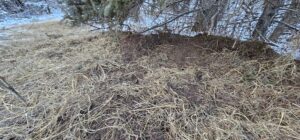Are Wild Pigs in Your Area? A Guide to Detecting Signs and Impacts
Invasive wild pigs are considered one of the most damaging invasive species in the world. Highly adaptable and fast-reproducing, they have successfully expanded outside of their native range and are now present on every continent other than Antarctica. When pigs escape or are released, they threaten the environment, communities and industries like agriculture and forestry. In Canada, provincial and territorial definitions vary, but generally speaking, invasive wild pigs are any pig – whether domestic, Eurasian wild boar, or a hybrid – that is uncontained and outside of human control.
A challenge with early detection of invasive wild pigs, is that they are good at staying hidden. Wild pigs are nocturnal, mostly active at night, and often change their behavior to avoid being seen by people. This means they might not be spotted directly, however wild pigs leave behind clear signs of their presence on the landscape. These “field signs” can include tracks, rooting damage, among other disturbances in the environment.
Recognizing these signs is essential for detecting new populations early, and successfully managing them before they become a bigger problem. In this article, we will explore “field signs” you might encounter and share how you can help protect lands and waters from invasive wild pigs.
Rooting:
The most common and obvious sign of wild pig presence, rooting is the result of wild pig foraging, as they tear up and dig through soil for feed found just below the surface. Wild pigs have a bone in their snout which aids in rooting, basically turning their snout into a trowel. The feed that wild pigs excavate include roots, tubers, fungi, invertebrates, and even small invertebrates. Rooting pigs leave behind large tracks of disturbed, tossed and torn up land.
Tracks:
Wild pig tracks are typical of most hooved mammals and closely resemble those of the white-tailed deer. Wild pig tracks are more round, coffee bean-shaped, and are as wide as they are long (5 to 6 cm in length and 4 to 7 cm in width). The best way to differentiate a wild pig track from other ungulates is through the presence of “dew claws” in some of the prints left behind. This is a result of the dew claws (lateral toes) being found lower on the leg; however, these are not always present, especially on hard ground.
Scat:
Wild pig scat (feces) can vary in size and appearance based on the size of the animal and what it was eating. Wild pig scat is irregularly shaped, sometimes resembling a segmented sausage, and can vary from 7 to 22 cm in length. The colour of wild pig scat is typically dark brown to black, but can have a purplish hue if the scat is fresh.
Wallows:
Like most mammals, wild pigs don’t have sweat glands and need to use alternative methods to thermoregulate. Wallows are a result of wild pigs rolling in mud and shallow puddles to cool themselves. Wallows look like shallow, muddy oval depressions with smooth sides where the pig rolled. Often multiple wallows are found together. Wallowing is also used to protect wild pigs from biting insects and parasites.
Rubs:
Rubs are where pigs have scratched themselves against standing objects, including trees, fence posts, rocks, telephone poles, etc. These objects are often found rubbed smooth and bare, with traces of fur or mud left behind. Rubs are typically found between 10 and 94 cm above the ground, depending on the size of the animal. Rubbing serves to mechanically remove ectoparasites like lice and ticks and are most often associated with wallowing.
Nests & Beds:
Wild pigs use nests for resting or for giving birth to their young. They create these nests out of stems, grass, leaves, twigs and other material found nearby. Their nests are oval in shape and can be anywhere from 1 to 2.5 m long and up to 2 m in width. Nests made exclusively for childbirth (farrows) are often constructed on an excavated depression of mud in dense brush with overhead cover.

Wild pig bedding made up of straw and grass. Image by Squeal on Pigs Manitoba.
Fence Crossings:
Wild pigs are large, strong animals, capable of creating openings underneath or through wire fencing. These openings typically resemble large arches in the fencing, often with traces of fur and mud caught in the barbs.
Tails:
Visible cleared and worn paths through forests and brush can be a sign of wild pig presence. Although these trails can be created and used by other game species like deer, it is a good place to look for hoof prints. Wild pigs will also utilize other manmade paths like hiking trails and unpaved roads.
Have you seen any of these field signs?
Everyone has a role to play in protecting our land and water from invasive wild pigs. You can help by reporting field signs and sightings to your local reporting authority at SquealonPigs.com.